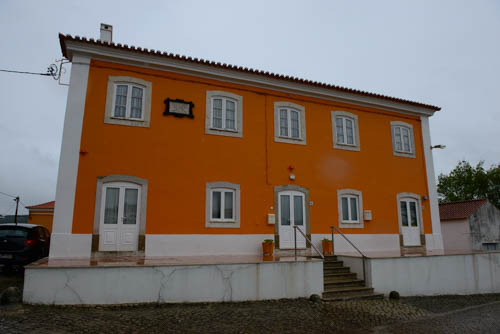Paul and Anne van Daan arrive at the Lines of Torres Vedras at the beginning of An Irregular Regiment, Book 2 in the Peninsular War Saga.
“Johnny reminded me how young you were,” Paul said quietly, reaching for her hand. “And as I heard myself say it, I realised that he might have a point. That at twenty you should be thinking about parties and fashion and jewellery and all the things that I should be able to give you. I’m taking you on a tour of redoubts and blockhouses instead of riding in the row and introducing you to George Brummell and the Prince of Wales.”
Anne began to laugh. “Should I like either of them?”
The redoubts and blockhouses referred to in the above quote were features of the lines of Torres Vedras, the extraordinary system of fortifications built by Lord Wellington to stop the French invading Lisbon in 1810.
It rained for two days in Torres Vedras when we were there.
It felt appropriate somehow. In An Irregular Regiment, the 110th Infantry arrives at Pero Negro on the lines of Torres Vedras in torrential rain. They weren’t as fortunate as we are, with a car and a comfortable hotel to come to, but then the Anglo-Portuguese army wasn’t used to luxury.
The weather on our first day was gorgeous, particularly later in the day. We drove out of Lisbon and found our hotel in Torres Vedras fairly easily although finding the car park proved more of a challenge. Torres Vedras is a lovely little town with cobbled streets. The Stay Hotel is in the centre, opposite the monument to the Peninsular War and I felt ridiculously happy to see it. Somehow it made it real.
Cobbled Street in Torres Vedras
We had lunch at a restaurant close by. Tapas at ‘Taberna 22′ was a delight with friendly staff and great food at reasonable prices.
The Lines of Torres Vedras were lines of fortifications built in secrecy on the orders of Lord Wellington to defend Lisbon during the Peninsular War. They were named after the local town and constructed by Colonel Richard Fletcher using Portuguese workers between November 1809 and September 1810. The lines stopped Massena’s invasion force dead when he arrived there and were so effective that the full system of fortifications was not completed as they were never needed. The French never got beyond the first line.
After lunch we drove out to the little town of Sobral which was the scene of a battle in October 1810 when the French army led by Marshal André Masséna arrived at the Lines of Torres Vedras.
Marshal Junot’s VIII Corps was engaged in the fighting over two days. On 13 October, the French drove back the skirmish line of Lowry Cole’s 4th Infantry Division. The following day, Junot’s troops seized an outpost belonging to Brent Spencer’s 1st Infantry Division, but were quickly ejected from the position by a British counterattack. Masséna soon decided that Wellington’s defensive lines were too strong to crack and elected to wait for reinforcements.
I had seen paintings of the combat in the town of Sobral but it was a strange experience to get out of the car in the square opposite the heritage centre and be able to recognise the buildings depicted in the battle scene which are still there. The heritage centre is small but the displays are very good and tablets are available with an English translation. We also bought an excellent little book about the lines which includes maps, suggested tours and a huge amount of detailed information about the forts and defences and how they worked.
Sobral, scene of the battle in 1810
Armed with this, we drove in the early evening up to Fort Alqueidao, one of the most important forts on the lines and the location of Wellington’s advance command post. Wellington would frequently visit the fort on horseback, riding up from his headquarters in Pere Negro or from the main signal station at Senhora do Socorro.
It was a beautiful evening and the perfect time to be up at the fort. The views were stunning and the light perfect for photography, I am assured by my resident expert. I was particularly taken with the section of Wellington’s military road which has been preserved. For some reason, reading and writing about his road building in Portugal, I had not really taken on board just how solid some of these roads must have been. Or how uncomfortable, for a wounded man being thrown around in an ox wagon.
Dinner in the evening was at another excellent restaurant in Torres Vedras, Restaurante Patanisca. Once again the food was superb, the service very friendly and there was a real local atmosphere to the place. We also discovered that we like the local wine…something else I apparently have in common with Lord Wellington.
Despite the rain we were out on a tour of the lines again the following day although I suspect we were rather more dry and comfortable than Paul and his regiment arriving at the lines after the battle of Bussaco in 1810 in driving rain and heavy mud.
For regular updates on this site including history, travel, book reviews and plenty of labradors (and a few freebies thrown in) please join the e-mail list here.





